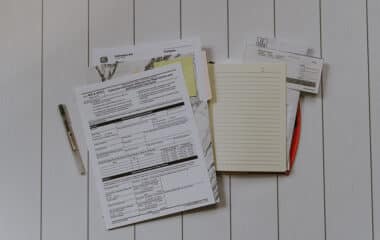Filing business taxes in a timely manner is an essential part of running your business, especially if you want to avoid unnecessary fees, interest, and penalties. In this guide, we will discuss what small business owners need to know about filing their taxes.
Filing Business Taxes: The Basics
Many people dread filing business taxes every year, and it can be daunting if you’re a new business owner and don’t know where to start. When it comes to taxes, the worst case scenario is having to spend hours sorting through old documents and filing business taxes only to find out you owe a tremendous amount that you weren’t anticipating or don’t have the budget for.
The best way to set yourself up for success is to keep good records. It also helps to work with an accountant on a regular basis. Doing this can help you project your business taxes throughout the year so you aren’t surprised. A good accountant can also help you take advantage of all appropriate deductions and credits available to your business. The IRS has plenty of information on how to file and pay your business taxes.
What is the minimum income to file taxes for a business?
If you are a new business or a sole proprietor you may be wondering what the minimum income is that requires you to file business taxes. In general, you can earn up to $400 in net income (income after you deduct your business expenses) as a sole proprietor without having to file business taxes. Any other type of business is required to file taxes regardless of the amount of income they earn.
Which types of businesses have to file taxes?
If paying businesses taxes is new to you, you may be wondering which types of businesses have to file taxes. The short answer is all of them. Whether you are a sole proprietor, an LLC, a partnership or a corporation, you will have to file business taxes. As mentioned before, the one exception is if you are a sole proprietor that had a net income of $400 or less.
What do I need to get started?
If you use PaySimple and have a good record keeping system, getting started with your business taxes is easy. All you need to do is give your accountant a copy of your business’s balance sheet and income statement (also known as a profit and loss statement). If you don’t have an accounting system, now is the time to sort your receipts and bank statements to list all of your income and expenses and give that information to your accountant. PaySimple has a list of the receipts to keep for tax time.
What Is The 2022 Business Tax Filing Deadline?
Keeping up with tax filing deadlines can be difficult. To make it easier, we’ve compiled a list of the typical tax filing due dates based on business types within our guide below. While you can file and pay your taxes later in the year, it is prudent to file your taxes sooner if you are owed a refund.
How To File Business Taxes In 2022
There are a couple of options for filing business taxes. You can do them yourself with an e-file tool (using an IRS-approved e-file provider), or you can work with an accountant or other tax professional. If you file business taxes yourself it’s helpful to understand the forms you will need to submit. For a sole proprietor or a single member LLC the most important business tax form to understand is the Schedule C (Form 1040).
The first step in filing business taxes is to gather all your documentation. If you’re working with an accountant, you can talk with them first and they will generally give you a list of documentation they need to prepare your taxes. Most importantly, they will need your balance sheet and profit and loss statement. If you don’t have that then they will need a listing of your business income and expenses for the year. If you drive for your business they will also want a log of the miles that you’ve driven for your business. If it’s the first time working with the accountant and you have an established business they will also want to see a copy of your previous year’s tax return. You should use this documentation even if you are self-preparing your taxes.
If you’re working with a tax professional, you will have an initial meeting with them (in-person, over the phone, etc.) where they will review your documents, and ask you questions to help you take advantage of business tax deductions and credits. For example, they may ask, “Did you work from home, if so, what’s the square footage of your house that is dedicated to your business?”, “Did you buy any equipment for your business?” and/or “Did you make any quarterly estimated payments?” You should also take a list of your own questions to the meeting so you can get those clarified with your accountant.
Next, your accountant will work on your taxes on their own and may contact you with additional questions they may have. Once they’ve completed your return, they will call you with the results, and discuss how it went, and what you owe or are getting back. They should also help you plan for the following year (if you need to make quarterly estimates, additional ways you can save on taxes, ways to avoid fees and penalties, etc.). If you have any items you forgot to record or share with them this is the time to bring it up to them.
Finally, your accountant will ask you how you want to pay the IRS if you owe or how you’d like to be paid if you are owed a refund. If you opt for direct deposit they will ask for your banking information. The accountant will mail or e-send (email, DocuSign, etc.) you their e-file signature forms to authorize them to file the return on your behalf. Once the taxes are filed, your accountant will send you a copy of your documents, and the bill from them. If you are getting a refund you should get it within a few weeks.
How To File Business Tax Extension In 2022
If you want to file for a business tax extension you will need to complete an extension form and send it to the IRS. The form you complete depends on the type of business you have. For example, if you are a sole proprietor filing a schedule C then you will submit a 4868 form. On the other hand, if you are a corporation then you will need to complete and submit a 7004 form. Remember: an extension of time to file your tax return is not an extension of the time you have to pay (if you owe taxes).
Conclusion
Business taxes can be stressful, but with the team and tools they don’t have to be. If you’re stressed and scrambling because you’re looking through months of old bank statements, you should consider using PaySimple to streamline your financial tasks moving forward.


